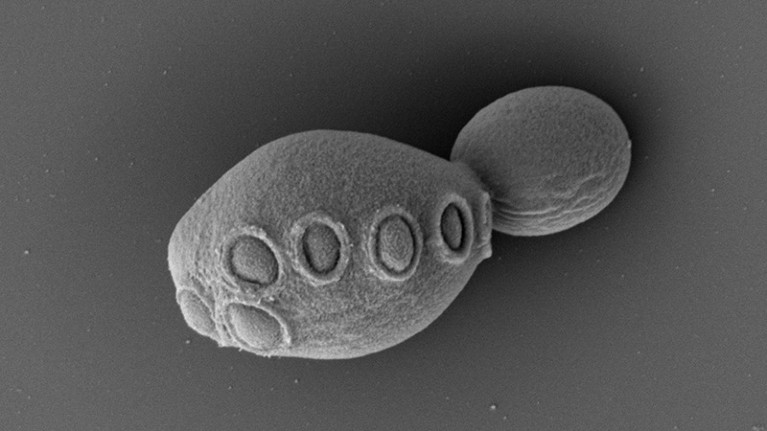Hello Nature readers, would you like to get this Briefing in your inbox free every day? Sign up here.
Yeast cells containing 7.5 synthetic chromosomes were able to bud normally, splitting into two cells.Credit: Cell/Zhao et al.
Yeast created with half-synthetic genome
Scientists have created a strain of brewer’s yeast (Saccharomyces cerevisiae) whose genome is more than half synthetic. Seven-and-a-half chromosomes were synthesized or stitched together in the laboratory. To make sure the genome was stable, biologists removed repetitive regions of DNA and sequestered all genes for transfer RNAs — essential for protein synthesis — in a single ‘neochromosome’. It’s a milestone for the Sc2.0 consortium, whose aim is to create yeast with a fully synthetic genome.
Nature | 3 min read
References: Cell paper 1, Cell paper 2 & Cell Genomics paper
History of humanity recorded in lice
One animal has accompanied humans on all of our great migrations: the louse (Pediculus humanus capitis). Its genetics might help to reveal the full extent of our travels. Researchers looked at the genetic variation in lice from around the world and found signs of a genetic link between lice in Asia and those in Central America that might be the mark of ancient humans’ arrival in the Americas. Supporting that theory, louse DNA seems to accurately reflect the known timeline of European settlers mingling with Indigenous Americans. “I see this as a proof of concept that human lice are good markers for human evolution and migration,” says molecular biologist and study co-author Marina Ascunce.
Science | 4 min read
Reference: PLoS ONE paper
Looters pillage Afghanistan’s heritage
Afghanistan’s peerless cultural treasures are being continuously looted, satellite images reveal. Researchers in the United States previously collaborated with archaeologists in Afghanistan to identify more than 29,000 archaeological sites, with help from artificial intelligence. Now their system is spotting sites defiled by picks and shovels, or overturned by bulldozers. “Since coming to power, the Taliban has taken some steps” to stop looters, says Noor Agha Noori, former director of the Archaeology Institute of Afghanistan, who is now a PhD student in Berlin. But “the borders remain porous, and there are no clear policies or laws and regulations to punish those violating Afghanistan’s cultural heritage”.
Science | 4 min read
Features & opinion
Life after the ‘great resignation’
“I have been overwhelmed with requests for advice on how to transition out of academia,” says neuroscientist Michele Veldsman, who made the move from a precarious academic career to a more attractive one in consulting. So many colleagues clamoured for tips that she created a community on the online messaging platform Discord. Veldsman and four other scientists share how they made the transition and what life is like on the other side. “Most importantly, sit down and really think about your values and passions, and reflect on how your career fits those things,” says Veldsman.
Nature | 11 min read
What’s in space right now
From a miniaturized library of artworks to an orbiting drug-development lab, The New York Times offers a playful, animated overview of some of the most interesting paraphernalia in space right now or heading there in the very near future.
The New York Times | Leisurely scroll
Podcast: How ChatGPT will change research
Generative artificial intelligence (AI), such as the chatbot ChatGPT, is already transforming research and scientific publishing — for better and for worse. Nature editor-in-chief Magdalena Skipper, journalist and features editor Richard Van Noorden and Yann Sweeney, the editor responsible for AI-related manuscript submissions at Nature, join host Nick Petrić Howe to discuss how these AIs are affecting science and what the future might hold.
Nature Podcast | 30 min listen
Subscribe to the Nature Podcast on Apple Podcasts, Google Podcasts or Spotify, or use the RSS feed.
Image of the day
Globular cluster NGC 6397.Credit: ESA/Euclid/Euclid Consortium/NASA, image processing by J.-C. Cuillandre (CEA Paris-Saclay), G. Anselmi, CC BY-SA 3.0 IGO
The European space telescope Euclid has released its first images, including a detailed view of the spiral galaxy IC 342. “This is the first telescope which can capture in one single exposure the entire galaxy and the surroundings with this exquisite resolution,” says Francis Bernardeau, deputy lead of the Euclid Consortium. (Nature | 4 min read)
